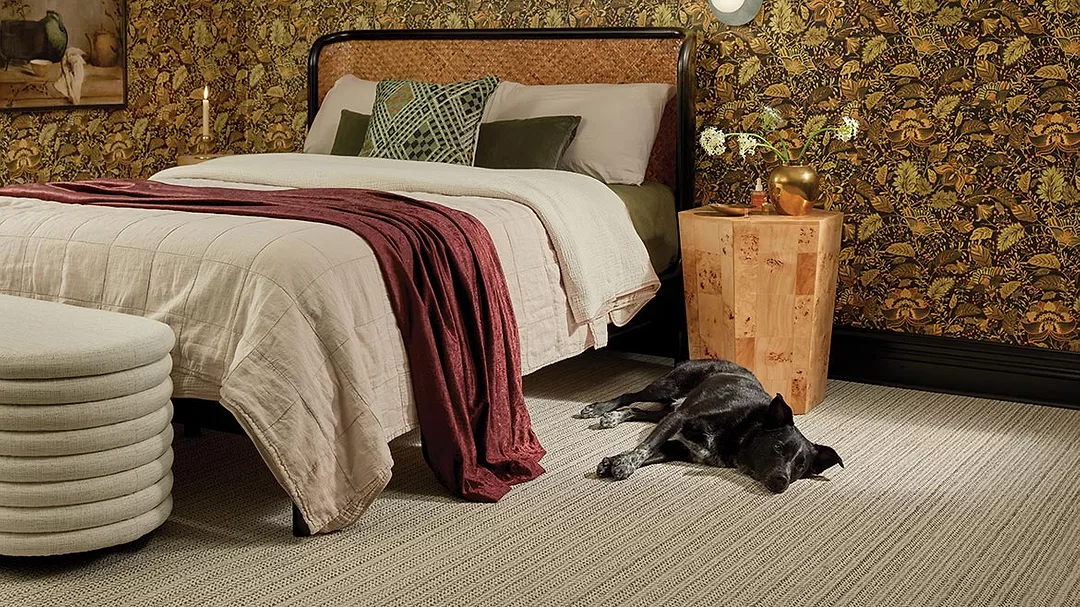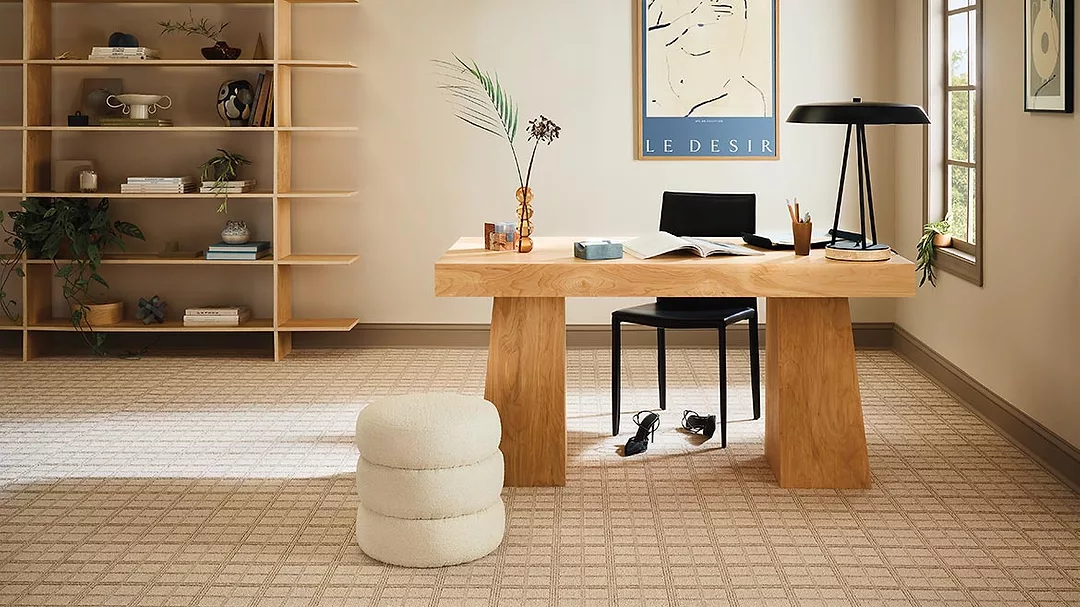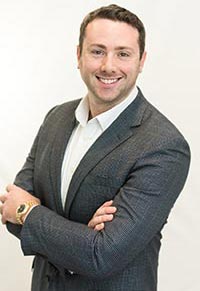Rising Leader: John Crews Vice President of Residential Product Development Soft Surface

A vibrant and elevated herringbone pattern gives the all-loop construction of Marquet a style that is both intricate and natural.
Photo: Anderson Tuftex.

Breeze Block grants permission to blur lines of symmetry with its lovely subtlety and premeditated imbalance.
Photo: Anderson Tuftex.
In Floor Trends’ new series, we’re meeting rising leaders who are making a big impact in flooring. Meet John Crews, VP of residential product development for soft surface at Shaw Industries. He shares his experience of climbing the ladder from intern to vice president of product development at Shaw, and how his first flooring collection at age 18 came to headline at HD Expo.
Floor Trends: How did you get into flooring?
Crews: I’ll start from the very beginning. I'm a native to Northwest Georgia, and flooring is what brought my grandparents to Dalton from the Northeast. I guess you could say that it was in my blood—not that I tried to pursue it, it just sort of happened that way. I originally was pursuing a fine arts background in high school and college, but in college I was an intern at Shaw in the hospitality division working for Pam Rainey. She was the first one who hired me. I became immersed in hospitality and really became interested in design. Coming from a fine art background, I was intrigued by the idea of thinking about the products I designed as art but thinking about them being functional. So that's why I'm so passionate about what I do.

John Crews
Floor Trends: So, you're an artist as well?
Crews: Not in recent years, especially since I think my artistic passion comes through in design these days. I love to make things that improve people's lives or that have a function, and that comes through outside of work through home renovation and different things that I do.
Floor Trends: How did you choose to focus on art in your education?
Crews: Growing up, that's what I was good at and it's what I enjoyed doing—drawing and painting and different things. It was a natural talent I was born with. As I interned in flooring, I was just really interested in how I could utilize that skill but in a different way.
Floor Trends: How did you get the internship at Shaw?
Crews: Through being a local, or northwest Georgian, and needing to have some kind of income while I was in school. In the summers and on the winter breaks I would work at the Calhoun office and I started doing strike-off requests as an intern assistant. In my free time I would create broadloom patterns for hotels, like corridors and things, just for fun. Pam was looking at my desk over my shoulders one day and she asked, “Where did this come from?” And I said, “Oh, I've just been doing this on the side.” And she said we should take this and you should work on a collection. And so I did, and it ended up being one of the collections they launched at Hospitality Design that year.
Floor Trends: Can you describe that experience?
Crews: Once I had the exposure and they sent me there—there were celebrity people there and I fell in love with the excitement. Nobody else I went to college with had any experience like that interning. I quickly just kept jamming my foot in the door at Shaw. I kept wanting to come back and I kept working on different things. As that hospitality segment got absorbed by Shaw Contract, I got exposed to that world as well. I really gravitated towards that brand and that was exciting.
Floor Trends: Tell us about that first collection.
Crews: When I was 18, I created a collection and it was inspired by graffiti art, like street art. It was bright neon orange, and it was really out there and wild. But Pam pushed me to keep doing something different and weird, and it was an attention grabber for sure. So that was just the beginning.
Floor Trends: How do you take a concept like graffiti art and turn that into a flooring collection?
Crews: The way we go about developing a concept is— and should always be—very different every time we do it. The source of inspiration should continue to change. It's become more and more consumer-driven, which I think is great, and more about things that people can respond to.
Back when I was starting out as an intern, the hospitality industry was very theme-driven. Every hotel you would go to had a very strong theme. If you go to Vegas, there's the Venetian, there's Treasure Island. But that evolved over time to where hospitality became more about a regional perspective. When you stay in Nashville, you want your hotel to feel like you're in Nashville. It doesn't need to feel like you're on a pirate ship or something. But the way we conceptualize changes over time with consumer preference. These days, we keep our eyes out for anything and everything and whatever resonates with us as designers.
Floor Trends: What are the tools you use?
Crews: I really could never decide what I wanted to do with my graphic design degree. I sort of knew that I would go into flooring, or at least start out at flooring. And obviously I'm still here, but as far as my team and where they start with their concepts, it varies depending on the designer. One of our designers in residential is a professional watercolor artist. One of our designers has an interior design background. So that diversifies the offering that they come up with. And so at this point, while I have a passion for creating my own stuff, the best way I can explain my role is as somebody who's thinks of it artistically. I think of myself sometimes as a museum curator where I try to make the team their best and they're exhibiting their work the best that it can be. I'm just suggesting how we curate those things, or how we bring them together, or how we exhibit those things.
Floor Trends: Is this an independent job, or are you working collaboratively?
Crews: I would say that it's all over the place. I've been traveling, and so I came in today and there were some beautiful new things all over the studio that different designers have been working on. And my head instantly goes to, oh, this can go into this program and we can give this style over here to this designer, and she can work on it for this program. We’re not territorial about our work or who's working on what. That's just the nature of the team that I came into. That culture always existed, which is amazing.
Floor Trends: How do you define your leadership style?
Crews: I'd say I'm a big picture more than detail oriented. When I work with somebody who is more detail oriented, I lean on that person and ask a lot of questions. But when I think of myself as being big picture, I think I'm able to see an end result. I can imagine what something can be. I guess that's part of being artistic is you're a visionary sort of trait that you have.
Floor Trends: What advice do you give to people who might want to follow in your career path?
Crews: I would say, and this is what previous leaders in role have told me, is that you have to be curious, you have to be passionate about it in order to be successful. What we do in product development—and every company has their own sort of style or the products—are really coming from the soul of the designer. You’re just not going to get great work unless it's sort of done with that artistic mindset. You do have to give a little bit of yourself away when you design products.
Floor Trends: Can you talk a little bit about the trends that you're seeing this year?
Crews: We do a different concept every year that drives all of our residential products. It's not to confine the designers, but it's sort of a track for the team and the products to really have a compass or sort of a consumer mindset to fit into. The products all look very different and they fit into their respective brands, but they also sort of fall under a trend that really guides per consumer preference.
For example, years ago we did Global Explorers where the designers went to different places across the world and the inspiration they brought back differentiated the products in their own. During the pandemic we focused on craft—the process by which a product is or something is crafted or the look of something that's handmade. That really resonates with times when everybody's locked inside because you're focused on what you're bringing into your home and that appreciation, the detail.
This year it was all about duality, meaning that it's two or more aspects coming together to create something balanced and soulful. The way we live our lives, everything's kind of merging and meshing with other things. Like the term “resimercial” has been around for a few years. We heard that a lot on the workplace commercial side, but now we're hearing it on the residential side in a very strong way. It’s the idea of idea of taking product benefits, product visuals, and bringing those together to create something new and special.
We had hard surface and soft surface designers switch roles to a degree and create prototypes across their comfort zone just to give our products a different perspective. When you think about soft surface, designers are working a lot with dimension and texture. They brought that to the table for hard surface and hard surface designers think a lot about modularity and how things come together. They bring this unique way of thinking about modular like rugs and different things to solve surfaces. That’s just a long way of saying that was kind of our guiding trend. We no longer see these trends of farmhouse or Zen garden. It's much more vague and ambiguous and people's experiences that make up their lives.
Floor Trends: Can you describe how this duality is expressed through Shaw’s new products in 2023?
Crews: Obviously, we launched our re-discovery of our Anso Colorwall at SFN Convention. And not only with there being a more vibrant color palette, I think it aligns more to where consumers are today. We launched our canvas comfort visual—we got rid of our solid cut pile on our Colorwall, which is a big bold move to make. We thought about the influence of commercial and the influence of pattern and texture and created this canvas visual for the home. This idea of taking the best of both worlds and breaking outside of the boundaries that we think of when we think of typical flooring and making something that it's a subtle canvas for the home, but it also is expressive and it's got a little flavor to it. So that's a good example of duality on that level.
With Anderson Tuftex, for example, new products Magna or Magna Modern Marquette that had this beautiful striated visual, the idea of taking visual cues from the handmade things that look like they're space dye and wool and woven, but offering the promise of Pet Perfect as a solution—a completely solution dye product. That's another way that we introduced duality into the mix.
Floor Trends: How do you distill all these ideas into cohesive collections?
Crews: We establish, establish the overarching concept and we just have to really vet through the process and make sure that it has appeal to everybody. And then as we develop prototypes within that, let's say that we develop prototypes sometimes without really thinking about where they're going to go. Is it going to go Anderson Tuftex or is it for Shaw Floors? Is it going to be part of our Pet Perfect program or Simply the Best? We developed good design first and we developed a wide variety of design that excites us. From there, we determine what programs or what types of consumers it makes sense for. And then we think about how do we fabricate it—working with manufacturing and our product development team that's more technical to bring it to life.
Floor Trends: So your creativity is not bound by brand.
Crews: Our design team has a blurring the lines more and more as time goes by, thinking about designer skill sets based on what people are interested and passionate about. My job is to make sure that all of those brands are different from each other and those product lines are different.
Looking for a reprint of this article?
From high-res PDFs to custom plaques, order your copy today!



.webp?height=200&t=1702928277&width=200)


